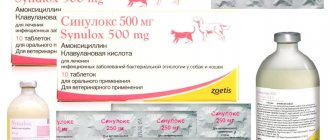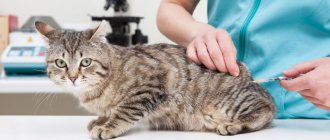In veterinary medicine, the pharmaceutical drug “Clamoxil” is actively used for cats. It is a semi-synthetic penicillin antibiotic with a wide range of action. "Clamoxil" is highly effective and fast-acting. It can be used to treat cats only with the permission of a veterinarian, who will examine the furry patient, make a diagnosis and, after assessing the severity of the animal’s condition, prescribe the necessary dosages.
Composition and storage conditions
Clamoxil belongs to the group of antibacterial agents. The main active ingredient is amoxicillin. Additionally included:
- aluminum stearate;
- Coconut oil.
These auxiliary components are necessary for the medicine to acquire the consistency of a suspension. The drug can be stored at a temperature not exceeding +25ºC, in a dark place inaccessible to children.
After opening the bottle, you can use the medicine for 1 month. If unopened, the packaging can be stored for 3 years. After the expiration date, the medicine cannot be used. It must be disposed of.
Pharmacological properties
The drug Amoxicillin is a medication that has a targeted bactericidal and bacteriostatic effect. It is a semi-synthetic antibiotic with hydroxo group. It exhibits the greatest activity against bacteria such as staphylococcus, salmonella, meningococcus, streptococcus, E. coli, gonococcus, Shigella Flexner, Klebsiella pneumoniae. In addition, the medication is often used as one of the components of complex therapy in the fight against the microbacterium Helicobacter pylori. When used in conjunction with Trichopolum, it suppresses the resistance of the above bacteria to metronidazole.
Microorganisms that produce the enzyme penicillinase remain unchanged when interacting with Amoxicillin.
When combined with enzymes that suppress beta-lactamases, the activity of the drug against microorganisms such as Legionella, Burkholderia mallee, and nocardiosis increases. At the same time, some bacteria remain resistant to the drug, including Pseudomonas aeruginosa and Serration marcescens.
Instructions for use
Dosage
The dose required for treatment depends on the weight of the animal. For every 10 kg of mass, 1 ml of the substance is taken. If the cat weighs less than 1 kg, 0.5 ml of the drug is drawn into the syringe.
There are 2 ways to calculate a single dose of medication. 150 mg of the active substance is contained in 1 ml of the drug, and 1 kg of weight should contain 15 mg of the drug. But most often, veterinarians select the dosage individually, taking into account the condition of the animal.
For a common cold, Clamoxil is administered once. If there are complications, the injection is repeated after 48 hours. If the animal’s condition does not improve within 2 days, it is necessary to show the pet to a veterinarian, because... The bacteria may be resistant to amoxicillin.
A specialist must conduct treatment and select a therapeutic dose of medication. The suspension is effective for 48 hours. In some cases, Clamoxil can be used in the postoperative period to prevent complications.
How to inject?
To treat animals, the suspension is administered subcutaneously or intramuscularly . It is advisable to have the injection performed by a specialist. It is more convenient to administer the medicine with an assistant: one person fixes the animal, the second gives the injection.
Clamoxil is administered slowly to minimize pain for the animal. The drug is injected into the withers or thigh area. When making an injection, the needle is inserted to a depth of ⅓ of its length. The puncture site is pre-treated with a disinfectant.
For a subcutaneous injection, the needle is inserted at a 45º angle towards the animal's spine. The rules of introduction are the same, slowly and in a stream.
In what cases is the drug prescribed?
The medication is used for food poisoning in cats, as well as in the presence of bacterial diarrhea. The drug is effective against inflammation of the lungs and bronchi, and has a detrimental effect on bacteria that cause cystitis. The medicine is prescribed to eliminate purulent lesions of the skin and mucous membranes, as well as to prevent postoperative complications in pets.
Penicillin antibiotics are prescribed in combination with other drugs to eliminate abscesses and other infectious complications in cats.
Side effects
Among the adverse reactions when using Clamoxil, the most common is allergies. In some cases, the beneficial intestinal microflora may be disrupted, and then the animal develops symptoms of an intestinal disorder, accompanied by diarrhea. Pets may have:
- Loss of appetite.
- Nausea and vomiting.
- Increased salivation.
- Lethargy.
If such signs are detected, it is necessary to stop treatment and contact a veterinarian, but only if they do not disappear for a long time.
This type of antibiotic is not used in the treatment of old and severely weakened animals. Since the drug is excreted in the urine, it is not recommended for use in pets with kidney problems. The medication cannot be used in conjunction with other antibiotics.
Some facts
Aflocrem emollient is a dermatotropic product produced by the Croatian pharmacological company Belupo. The hypoallergenic cream was developed for intensive care of hypersensitive and dry skin. It does not contain parabens, synthetic preservatives or dyes that can cause unwanted allergic reactions. Used to moisturize children's skin, as well as hypersensitive skin on the face, elbows and other areas of the body.
Aflocrem emollient is an effective care product for problematic and hypersensitive skin. Does not contain fragrances or dyes, which reduces the likelihood of allergic reactions and dermatitis. Regular use of a hypoallergenic product allows you to normalize lipid metabolism in tissues, restore the pH balance of the skin and strengthen local immunity.
Pregnant, lactating and kittens
The drug is not recommended for the treatment of pregnant animals, especially if there is very little time left before birth. The antibiotic negatively affects future offspring. An exception is made for those females who are in poor condition. In this case we are talking about the life of an animal.
You should not give injections with this antibiotic to nursing cats. The drug is prescribed to kittens with caution in cases where the critical condition of the animal requires it. The dose is calculated only by a specialist.
Principles of drug toxicity
The likelihood of an adverse and, in particular, toxic reaction can be influenced by various factors. The organs most susceptible to type A adverse reactions are usually the organs exposed to the greatest drug exposure or concentration. Thus, organs with the highest blood flow and organs that can concentrate drugs, such as the liver and kidneys, are most vulnerable to systemic drugs.
Highly metabolically active organs can also exhibit toxic effects for two reasons:
- Such organs depend on the presence of energy, and anything that impairs the supply of energy (including blood flow) can lead to disruption.
- When the metabolic activity involves the metabolism of compounds, the production of potentially reactive metabolites may increase the likelihood of cytotoxicity if these metabolites interact with cellular structures.
The organs most vulnerable to damage by type B reactions are typically those containing tissues that act as haptens for drug allergies (eg, skin, blood-forming blocks) or tissues that filter and trap immune complexes (eg, glomeruli and joints). Organs containing large numbers of mast cells may also exhibit immune-mediated reactions (i.e., “shock” organs, see “Allergic Reactions”). Not all adverse reactions are clinically significant. Sometimes reactions cannot be detected unless they are actively looked for. For example, clinical laboratory testing may detect drug-induced hepatotoxicity (eg, increased serum alanine transferase activity) that does not cause clinical symptoms. Many drugs may directly interfere or indirectly interfere with clinical laboratory tests, including endocrine function tests. If an adverse reaction to a drug is suspected, the importance of reporting it (or suspecting it) cannot be overemphasized (see below). An organ's susceptibility to drug toxicity may change throughout the day, for example aminoglycosides and cisplatin (To 2000) exhibit increased nephrotoxicity in humans when administered in the evening compared to the morning. For aminoglycosides, safety in the morning was attributed in part to the increased rate of glomerular filtration that occurs in the morning; increased sensitivity to interleukin-6-induced inflammation has been suggested for cisplantin.
Two mechanisms by which drugs can induce cell death are apoptosis and necrosis, each with distinct morphological and biochemical characteristics.
Apoptosis is an active process characterized by cell contraction, nuclear and cytoplasmic condensation, chromatic fragmentation and phagocytosis.
In contrast, necrosis is a passive process that results in inflammation associated with swelling of cells and organelles, rupture of the plasma membrane, and leakage of cellular contents into the extracellular environment.
Best articles: Is it possible to feed a cat milk?
Since apoptosis is an active process, it is necessary to maintain sufficient intracellular energy; a decrease in ATP can cause the transition of the apoptotic process to necrotic. Not surprisingly, mitochondria play a role in apoptosis. Some toxic substances may exert their effects by interfering with mitochondrial function and thus ATP production.
Reviews
Owners
Marina K., Sevastopol:
“I was forced to give antibiotic injections to my cat during a severe cold myself, because... There was no way to go to the vet. The first time it didn't work out very well. The suspension is thick. Then I shook the bottle, and the second time everything worked. 2 injections were enough to improve my Musya’s condition.”
Maria L., Moscow:
“My cat urgently needed help; no other drugs except Clamoxil helped. She felt better after the first injection. Despite all the concerns, there were no side effects.”
Veterinarians
Rimma V. veterinarian, Vladivostok:
“I prescribe Clamoxil quite often, especially when the animal’s condition is alarming and there are no other ways to provide help. The drug acts quickly. It has low toxicity, unlike other potent antibiotics.”
Roman S., veterinarian, Smolensk:
“Clamoxil is excellent for treating almost any bacterial infection. I had to deal with side effects no more than 2 times during my entire work.”
Analogs and price
The drug can be purchased at a pharmacy or ordered on a specialized website. It is sold in 100 ml bottles. The average price of 1 bottle is 748 rubles.
Analogs of the drug are Tsiprovet, Sinulox, Sulf. Their release form is tablets, so it takes longer for them to start working. Once in the stomach, the medicine is partially destroyed by acid.
If you are individually intolerant to the components of Clamoxil, you can replace it with another medication. This product is not available in tablets.
Drugs with similar effects - table
| Name | Release form | Active ingredient | How to use | Indications | Contraindications | Price |
| Tsiprovet | Tablets and drops | Ciprofloxacin | Inside, on an empty stomach, 1 time per day. 1 tablet must be crushed and mixed with water, then given to the pet. The course of treatment is from 3 to 5 days. | Infections:
| Hypersensitivity to components | From 140 rub. |
| Sinulox | Pills | Amoxicillin+clavulanic acid | Orally, before or during meals, 2 times a day. The tablet should first be crushed and mixed with the food. Can be given forcibly with water. The course of treatment is up to 7–10 days. |
|
| From 250 rub. |
| Sulf 120 | Pills | Trimethoprim and sulfadiazine | Orally, along with food, 2 times a day. It is recommended to crush the tablet first. |
|
| From 160 rub. |
Medicines that can replace Clamoxil - photo gallery
Sinulox helps with various infectious diseases in cats and dogs
Ciprovet is active against gram-positive and gram-negative microorganisms
Sulf 120 - broad spectrum antibiotic
Clamoxil relieves your pet from inflammatory diseases caused by bacterial infections. In recommended dosages, the drug does not have a negative effect on the cat’s immune system. However, this medication should not be used without a veterinarian's prescription. It is important to first familiarize yourself with all possible contraindications.
Let's sum it up
Clamoxil can be used to treat bacterial infections of any origin. After introduction into tissues, it easily penetrates all organs and systems of the body.
The maximum concentration is achieved within 2 hours after the injection. There is a long period of time between injections, because The therapeutic effect lasts for 2 days, and there is no need to further injure the animal.
The main advantages of the product are low toxicity and high efficiency. The downside is the adverse effect on the kidneys and liver.
In some cases, in addition to pathogenic microorganisms, beneficial ones also suffer. Therefore, sometimes after treatment it is necessary to restore the intestinal flora. In terms of the degree of effect on the body, the drug is classified as a moderately dangerous compound.
Operating principle
The active component begins to act almost immediately after entering the body. Penicillins bind to pathogen membrane proteins, which are necessary to maintain its integrity. Amoxicillin acts on the rigid structure of the microbial shell, due to which it is destroyed and the bacterium becomes unviable.
When penicillin enters the body, it destroys the wall of the microbe
In the body, the active substance is distributed throughout all systems. The exception is the spinal cord, where amoxicillin enters in small quantities. The medicine is eliminated from the body very quickly through the kidneys. Therefore, if your pet has problems with the functioning of the urinary system, it is important to notify your veterinarian before starting treatment.
After administration of the drug, it acts for 18 hours. It is important to monitor your pet's response to the medication and if unwanted symptoms occur, you should notify your doctor.











